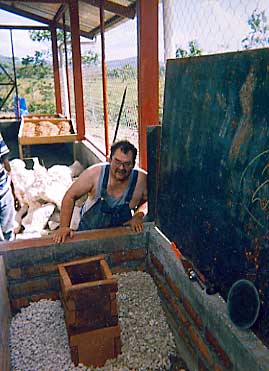 |
 |
 |
 |
 |
 |
Dean Still, Aprovecho, March 2002
Dr. Larry Winiarski has just returned from Nicaragua where he helped to
design and build a prototype wood fired dryer for cacao beans. The dryer
was financed by USAID, for the local group ACODEMUBE. The project was
facilitated by the Winrock International Clean Energy Program. Larry spent
about two weeks working with Winrock to build and test the first of four dryers.
Six pictures of the dryer are posted here on CREST.
The dryer is based on the Rocket style plancha (griddle) stove design.
Sticks of wood are fed into a foot square opening, the horizontal feed
magazine, that leads to the base of an equally sized three foot high
vertical internal chimney made from ceiling tiles called baldosa. The feed
magazine and internal chimney are in the shape of the letter "L". The
combustion chamber and internal chimney are surrounded by light weight
pumice rock that insulates around the small fire. The griddle is four feet
wide by ten feet long and sits on top of a brick box containing the firebox
and internal chimney. Pumice fills the entire box leaving only a one inch
gap between the rock and the underside of the large griddle. The opening of
the internal chimney is level with the pumice surface. Hot flue gases pass
through this one inch gap exiting out of the back of the box into a 12 foot
high chimney.
A metal box, open at the bottom, elevated one inch above the griddle, holds
the trays of beans. A clear plastic cover is supported above the trays of
beans and this cover is held by air pressure against the sides of the
supporting box. Air is sucked in through the one inch opening and is pulled
through the trays. The moist air then travels through the tunnel created by
the clear plastic and exits in a chimney that surrounds the inner chimney
connected to the fire. The larger external chimney, 20 feet tall, is warmed
by the heat passing through the inner chimney, which helps to create better
draft. This increased draft helps to shorten drying periods.
Drying only requires temperatures around 140F. In use, the 12" by 12" fuel
magazine is about one third full of sticks when in operation. Of course,
adding a small fan increases productivity. Since it frequently rains in this
locale, nearly every day, solar drying is difficult which makes wood fired
drying necessary.
Check out the photos!
 |
 |
 |
 |
 |
 |
Dean Still, Aprovecho, March 2002